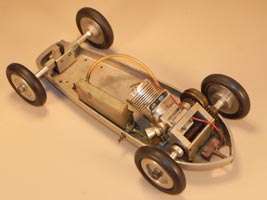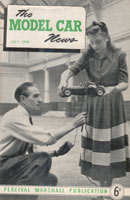

|
Home Updates Hydros Cars Engines Contacts Links Page 8 ← Previous Next→ Pit Box Index |
|
Pit Box |
| M&E ERA | Jack Cook's #6 | Berreta Rosso | 1066 MRC |
| 1066 MRC | Home build ED | ZN 5cc | E&M Maserati |
| Oliver Mercedes | King's Viper | Juneero Bantam | 2 Ekestrand Class 1 |
| Wreford style | M&E Special #1003 | Pulse Jet car | 3 M&E Wasps |
| 1066 style |
|
|
M&Es finest The ERA body supplied to special order
by M&E must be the most detailed ever for a commercial tethered car,
correct even to the manufacturers badge above the radiator grill. The
dummy exhaust has a minutely perforated heat shield as on the original,
whilst the myriad of punched and hand cut louvres almost defies
description. That each of these bodies was carved by hand from solid
pine is even more amazing. The ERA bodies discovered now heavily
outnumber the scale Austin GP, of which there are still only two known
to exist. Chassis number for this car is 1468, while the body
number is 18, but with additional initials of DG. |
|
|
Number 6 Jack Cook, another Sunderland Club member,
was at the forefront of British tethered car racing through to the late
1950s, breaking records and winning the European Championship along the
way in the 5 and 10cc class using Dooling motors. The 5cc cars were all
home built and numbered, 6,7,8 and 9 his record breaker. The number 6
leads us to believe this to to be one of the earlier versions, which
probably had a magneto at some stage, hence the cam arrangement on the
axle. The provenance of these two cars has only been established in the
last two weeks. |
|
|
Berretta Rosso This is one of three cars built by Ken Procter from Sunderland and described in contemporary magazines. Ken, along with Jack Cook and Jim Dean were amongst the last British competitors in Europe in the late 1950s. By then, most people had moved away from the Oliver twinshaft preferring to use a conventional Tiger motor on a spur mount, which allowed a more useable range of tyre sizes. The 'Berreta Rosso' (Red Top) was fully described in Model Maker late in 1957, one of the very last tethered cars to appear in that magazine. Thanks as ever to Ron Reiter for the Photo and item Oct 2013 |
|
|
More 1066 It would be interesting to know just how many thousands of kits and parts for the MRC were produced? There is still reckoned to be a hoard of parts down in Kent and items keep popping up like the two shoe clutch on ebay in June. This example has the cranked rear radius arms and the later three shoe centrifugal clutch on the Falcon motor. Could this be a genuine 1066 fuel tank behind the motor? The home built body and the chassis are now undergoing restoration and the owner is actively searching for the missing parts. Thanks to Mark Best for this item and the photos. August 2013 |
|
|
1066 MRC This is probably the most common of the
British commercial tethered cars, but what is relatively rare is the
1066 Hawk
motor as can be appreciated by its serial number 32. This is the earlier version
of the chassis with the cranked rear radius arms but with the engine located
further back to accommodate the later three-shoe clutch. The car has been
superbly restored by its owner, whilst the Hawk has received some expert
attention from Mike Crisp in deepest Suffolk. Yet to see an original tank or
battery box as shown in the catalogue though? |
|
|
How Much? This unremarkable home built car came up
for auction in deepest Suffolk last month. With its ED Racer motor, ED
Speedicord tyres and a very crude bent aluminium chassis, the estimate
of £200-£300 was about right. It doesn't seem to have run as the twin
exhaust stacks are hard up against the body shell. No the photo is not
the wrong way round either, the builder put his numbers on back to
front. Oh yes, the hammer price £1,000, yes that's right, £1200 with
premium??? |
|
|
ZN 5cc Paul Zere of ZN Motors in Hendon was one of
the few people producing cars and components commercially for the 5 and
10cc class, which he continued through to the end of the sport. The 5cc
car was based on a pressed aluminium pan and body with a spur drive
mounted motor, usually a Dooling 29. Zere had intended to produce his
own motors, but this was scuppered by the imposition of purchase tax.
This rare example has a mixture of wheels rather than the correct ZN
items and since this photo was taken has been restored and left for the
US. |
|
|
More Maseratis Another example of Mr Knowles'
once rare
E&M
Maseratis. The Retro Club magazine featured an extensive article trying
to identify which prototype this was actually modelled on, and given
that most of the cars of the period featured massive engines in the
front and the driver at the back, the most likely would seem to be the
Bi-Motore. This would account for the 'driver' being in the middle as
there was another engine in the tail section. This lovely example is missing
its motor and accessories, but is in otherwise 'sparkling' condition. |
|
|
A stunning and original Oliver |
 |
 |
 |
|
A fine piece of engineering. This lovely example of British engineering was discovered in the US by John Lorenz and it is one of those wonderful 'finds' that has come from the family, along with other material. It was built by George King, a member of the Pioneer Club who is seen above at their racing venue, the Horticultural Halls, along with his daughter. Both George, his daughter, and his cars featured in Model Car News, but of 'Viper' we can find nothing. The entire car, with the exception of the tyres, is built from scratch, including the 10cc motor and motor mount that are entirely fabricated and superbly engineered. Any further information about George, his daughter or his cars would be very much appreciated by John and ourselves as we would like to produce a more detailed 'Pitbox special' to record George King's involvement with tethered car racing. Thanks to John Lorenz for images and information. Feb 2013 |
||
|
|
The 'Bantam' |
|
|
Tiny record breakers For a long while, Stan Barrett was the sole British competitor in the two smallest classes of tethered cars. Sadly he has now retired from the sport and these two diminutive 1.5cc screamers have found new homes. Here we see the current British record holder (219.781kph) along with a stable mate for one last photograph. Thanks to Peter Hill. OTW photo Dec 2012 |
|
|
Commercial 'Wotzit' All the parts of this car, including the two-piece cast body are commercial but we cannot find any references to what it might be. All the running gear is from J.S. Wreford of Romford, and we wonder whether this was a replacement for the earlier Half Pint which was all made from pressed sheet aluminium? What cannot be seen is the front axle which allows the steering to be adjusted. The motor is an Allbon. Thanks to Alan Whitehead for this item. OTW photo Nov 2012 |
|
|
Definitely 'Special' What is unusual about this otherwise standard M&E Special is the serial number 1003, making it one of the very first production models in 1947. It is not entirely complete, missing bridles, the coil and condenser bracket and the knock-off, but what is there is absolutely original and genuine M&E, including the twin feed tank, which is rare. Also unusual is the full compliment of body clips, springs and brass studs. The body is numbered 12, which we still do not understand the full significance of. Thanks to Alan Whitehead for this item. OTW photo Oct 2012 |
|
|
A 'fearsome beast' Pulse jets (and later, turbines) remain banned for cars and hydros, although, as seen previously, it does not stop people building and running them privately. This car from the collection of the late Gerry Buck has a simple plate chassis, ZN wheels and a 1066 body barely containing the Juggernaught jet. Whether it was ever fired in anger or run is unknown at present, but it would certainly be impressive, as anyone being near a pulse jet when running would confirm. Thanks to Ron Reiter for this item and photos. Sept 2012 |
|
|
|
|
|
A 'swarm of Wasps' The Wasp was the smaller C class car produced by
M&E Models of Exmouth. On the left is a true 'Barn Find' that is
awaiting restoration, while in the centre eBay listing there was the
bonus of an original and undrilled chassis as well as two new body
sections. The version on the right is the most complete, including a
'Penny Slot' ED and original M&E Wasp clutch. Further details of all M&E cars
are available on the M&E page.
|
||
 |
 |
| 'Time Traveller' Quite a bit of 1066 influence here
with original chassis, gearbox, wheels tyres and rear suspension. The
steering has been abandoned and front suspension has been re-engineered,
but the intriguing feature is the use of a Westbury Kestrel motor with a
magneto driven from the rear of the crank. The Kestrel is unusual in
having the rotary disc running on the front face of the crankcase making
this conversion somewhat easier. The simple body is very effective and
is another example of early British tethered cars from Ron's extensive
collection. |
|
©copyrightOTW2012